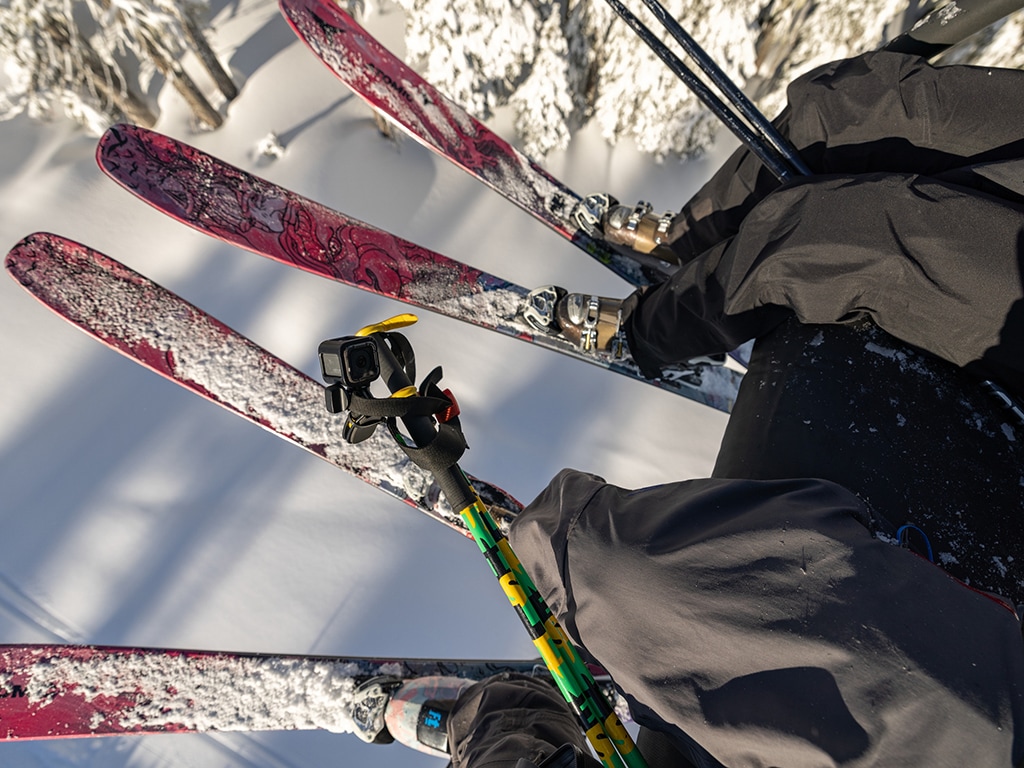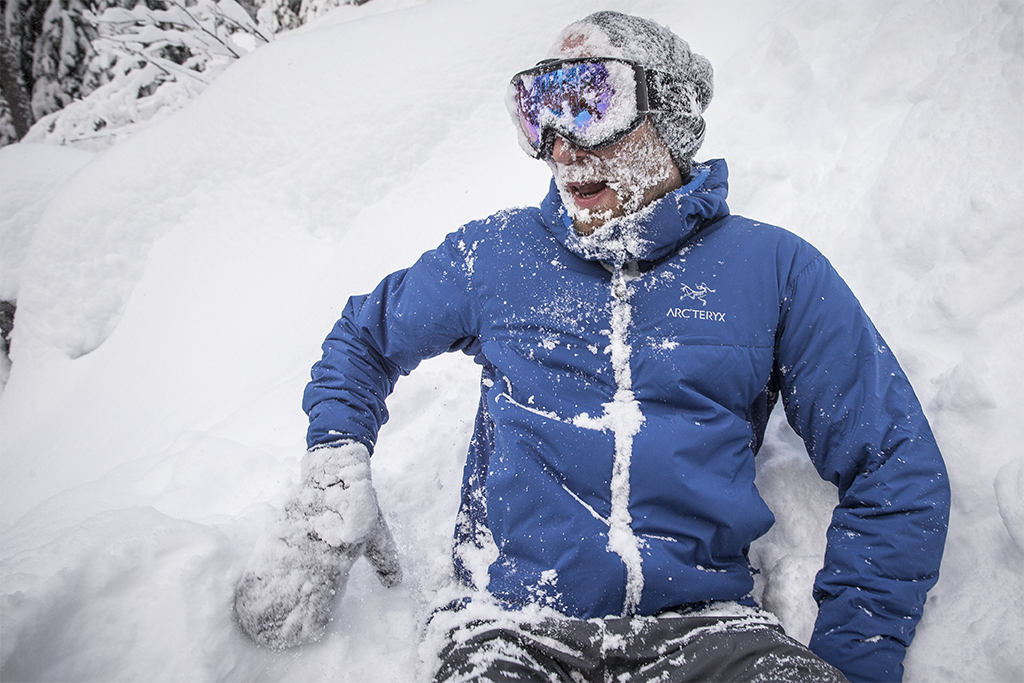The whooshing of your skis carving powdery pistes, the crisp mountain air filling your nostrils, the enchanting snow-laden landscapes all around—for generations, this has been the stuff of winter-vacation fantasies. But the effects of climate change pose a significant problem for today’s winter sports industry. Facing shorter ski seasons, warming temperatures and decreasing natural snowfall, ski resorts are increasingly reliant on artificial snowmaking operations to keep the slopes open and sustain their bottom lines.
As many as 95% of the world’s ski resorts now employ snowmaking, according to one recent study. And numerous media outlets were fixated on the topic during the 2022 Beijing Olympics, the first Winter Games to rely almost entirely on machine-made snow.
While many winter sports enthusiasts feel that machine-made snow is better than no snow at all, it’s important to consider the environmental costs of snowmaking. Environmentalists caution that the machines used in the process consume vast amounts of energy and water and can damage local ecosystems. Ironically, many snow machines are also powered by fossil fuels—contributing to the very climate problem that has made them a necessity in the first place.
Here, we investigate the ecological costs of machine-made snow and touch on what the broader issue of climate change means for the future of winter sports. Plus, we lay out actionable steps that individual travelers can take in order to plan more sustainable snowsports vacations, as annual winter snowfall in the U.S. has dropped by nearly 50% since the 1970s.
The History of Snowmaking
Humans have been manufacturing snow since the 1930s. By the 1970s, snowmaking technology became more widespread for sport use in the U.S., and by the 1980 Winter Olympics in Lake Placid, New York, artificial snow featured for the first time. Today, snowmaking machines are nearly ubiquitous at ski resorts, serving to produce machine-made snow in place of—or as a supplement to—natural snow.
Adrienne Saia Isaac, director of marketing and communications for the National Ski Areas Association, a U.S.-based trade association for ski area owners and operators, explains that one of the benefits of snowmaking is the consistency in snow cover it affords. “You can control the type of surface you put down, so it creates a very durable surface for the season.”
That consistency becomes a type of insurance policy, assuring ski resorts (and their customers) that they’ll remain open throughout the winter. Oftentimes, the snow machines are used to extend ski seasons (and revenues) into late autumn and early spring, including the lucrative fringe-season holiday periods that kick off at Thanksgiving and wind down at Easter.
“Providing a consistent product, and a start and end to a season, is really important—especially for rural communities who rely on winter tourism and recreation as part of their economy and their employment opportunities,” Isaac explains.

The Climate Crisis and Machine-Made Snow
The changing climate, with rising temps that are thawing and shortening winters, means there are fewer worldwide ski resorts that can reliably offer winter sports in natural conditions. One study determined that the U.S. ski season was reduced by more than a month (an average of 34 days) between 1982 and 2016; in Europe, the findings have been similar. A separate Environmental Protection Agency–funded report projects that almost all U.S. ski areas should anticipate having at least a 50% shorter season by 2050.
Drought conditions, which are also exacerbated by climate change, pose yet another potential barrier to the feasibility of water resource–intensive snowmaking.
For the snow cover–reliant ski industry, that leaves some big questions on how to effectively adapt. Snowmaking is generally viewed as a Band-Aid solution to the larger climate problem, and it’s also not without its own limitations.
“Climate change is affecting not only natural snow, but it is affecting the snowmaking operation as well because without cold air and the right temps we can’t do it,” says Isaac. “If you’re only getting 35-degree days, you can’t freeze water; 40-degree days, it doesn’t happen.”
How Snow Is Machine-Made
The recipe for machine-made snow calls for air, large amounts of water and suitably cold temperatures, as well as the heavily powered machinery and human snowmakers to manufacture it. Snowmaking attempts to mimic the conditions of natural snowfall, traditionally employing snow guns (aka snow cannons) which are positioned along the slopes. The machines then shoot small water droplets mixed with compressed air (sometimes enhanced by chemical or biological additives), which freeze in the cold air before the resulting product falls to the ground as snow.
Notably, while both natural and artificially made snow are essentially frozen water, manufactured snow is more of a densely packed pellet than a softer “powdery” flake.
“Our snowmaking equipment creates a snow particle similar to a graupel [pellet-shaped frozen precipitation], where natural snow comes in many different shapes and sizes,” explains Brooke VanderKelen Alba, sales and marketing head for snowmaking company SMI Snow Makers. It’s a shape that, she says, “makes our snow more resilient to the thaw/freeze cycles and allows for a more consistent snow quality across the slope.”
Isaac emphasizes that the machine-produced snow itself is not “fake,” like you might see in the movies or in holiday displays, but rather a mixture of the natural resources of water and air. “What you see coming out of snowmaking might be machine-made. It’s not made by Mother Nature. But it’s still very real.”
The Seen and Unseen Costs of Snowmaking
Snowmaking is resource-intensive, requiring abundant water and energy—factors that environmentalists warn can spawn negative ecological consequences.
According to one report, it takes 200,000 gallons of water to cover an acre with a foot of snow, while ski areas are capable of converting 5,000 gallons of water into snow per minute. Snowmaking advocates state that 80% of the water utilized returns to the watershed. Yet environmentalists have raised questions about diverting water resources during times of water scarcity, as well as the potential for altering natural water cycles and water table levels.
The enormous amount of power consumption required for snowmaking is another concern, with many resorts still reliant on carbon-spewing fossil fuels for power. Some estimates put snowmaking behind two-thirds of a ski resort’s energy needs.
Other ecosystem concerns have been raised around noise disturbances to local wildlife, and disruptions to vegetation and soil composition underneath the artificially made snowpack.
Beyond environmental concerns, numerous reports have indicated safety concerns for winter sports participants given the harder and faster surface of artificial snow, which may heighten the risk for injuries during falls.

The Future of Machine-Made Snow
“The risk is clear: man-made warming is threatening the long-term future of winter sports,” a recent study cautions, adding that ski resorts’ heavy reliance on artificial snow “could become the norm over time as our planet warms, starting with lower-altitude slopes and raising pressure and costs on higher resorts.”
Dr. Madeleine Orr, program director for Sustainable Sport Business at Loughborough University and co-author of that study, explains that lower-elevation resorts are generally lacking cold enough temperatures to naturally sustain a lengthy ski season. “So far, snowmaking has been the technology keeping it tenable, but that may not be sustainable by the second half of the century,” she says.
Indeed, if warming trends continue, snowmaking itself may no longer be possible at many existing ski destinations.
Orr says, “If the days are just too warm, even artificial snowmaking is insufficient. You can power up all the snow guns you want, but if it’s not cold enough for the crystals to form, or if the snow melts once it touches the ground, you’ve got nothing to ski on.”
Instead, Orr believes skiers will have to travel farther to access higher-elevation resorts, adding travel time and expense to the wintry mix. “In general, this might mean fewer people are able to ski toward the midcentury.”
Sustainable Strides in Snowmaking
Many resorts are already embracing increasingly sustainable snowmaking solutions, including more efficient machinery and cleaner renewable power sources like solar panels and wind turbines.
“There are some great innovations happening in this space,” says Orr. “Powering the system through renewables, leveraging as much water capture and reuse as possible and designing systems that last 30, 40 years or longer, are all solutions being implemented across the industry right now.”
Still, some environmentalists say that snowmaking is merely an adaptation strategy, and its impact is negligible when it comes to the large-scale threat of climate change.
“The real issue is reducing emissions enough to slow warming, stabilize precipitation patterns and hold a more stable, consistent snowpack throughout winter,” explains Torrey Udall, chief of staff at the nonprofit Protect Our Winters. “We do that through systemic changes to the way that we make energy and move around in ways that produce zero, or at least significantly lower greenhouse gas emissions.”
How to Choose More Sustainable Snowsports Vacations
Experts say individual travelers can take steps to help ensure a cleaner, greener winter sports vacations—like traveling at times when mountain conditions are more likely to be right for natural snowfall, or to destinations that don’t require snow machines.
“Go when and where you don’t need to rely on artificial snow,” says Tim Williamson, customer director at U.K.-based travel company Responsible Travel. “So go high altitude or go in midwinter. Avoid low-lying resorts and the shoulder season.”
Choosing ski resorts that embrace sustainability efforts in their operations is another smart choice. (If your favorite resort isn’t listed as a Sustainable Slopes endorser, consider recommending a sign-up to management.) Travelers can also make efforts to reduce their own carbon footprint while getting to their destination by forgoing planes for trains or electric vehicles, for instance, or carpooling or riding a bus or shuttle to the slopes.
Finally, experts say to use your voice: Contact resorts, tourist boards and, most importantly, legislators to express your concerns—and, ultimately, make your voice heard through your choices.
“You don’t have to be a scientist to be a climate advocate,” says Isaac at the National Ski Areas Association, who believes the solutions must happen at the government level. “If you love skiing, protect it and protect the water sources and work with your elected officials to implement broadscale regulatory and legislative change.”
“We need every solution and everyone onboard in order to make sure that we have snowsports in the future.”



